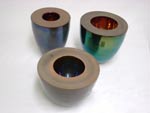 Ferenc Halmos
Ferenc Halmos
Zinc Silicate Crystalline Glaze Pottery
NOTES
EOSIN: Reduction Overglaze Lustre Glazes
This rare and complicated glaze technology, which originated from the Middle East, has been known for some 1200 years. European potters learned the technique of applying gold-colored silver and red copper coating, together with the manufacture of tin-glazed majolica, from the Moors.
In the 19th century English, French, Italian and Spanish potters further developed the lustre glazes of the Italian Renaissance. Vilmos Zsolnay, following in the footsteps of William de Morgan, Clement Massier and Theodor Deck, and relying on the initial help of chemists Lajos Petrik and Vince Wartha, experimented with and introduced a number of original lustre glazes. He called his glazes which changed color during firing "eosin". The especially rich, overglaze lustre Eosin became the Zsolnay factory's trademark technology. The various phases of this special glazing and firing technology were tested, improved and further developed in the course of 15 years of experimenting.
The essence of the lustre glaze technique is that the bisque-fired glazed or acid-matted surface is covered in a clay iron oxide paste which may contain copper, silver or any other heavy metal. The painted objects are placed in a firing muffle and heated to 550-650°C until the glaze softens. Following this the kiln atmosphere is set for the reduction phase. The steam the metals give off sticks to the glaze and forms a colorful lustre which can be seen once the product has cooled and the slightly burnt paint paste washed off. This is a complicated and delicate technology which is extremely hard to reproduce.
The previous text was written for the exhibition at Herend Porcelánmúzeum Herend Múzeum-Halmos Ferenc - Játék a mázakkal (April 22 to June 30, 2005). http://museum.herend.com/hun/kiallitasok/mult.htm
The book "Lustre Pottery" by Alan Caiger Smith describes this technique and helped start Ferenc's experiments with these glazes. He comments that Smith writes completely false assumptions about Zsolnay's technik with "Zsolnay did not work with the original paste lüstre, only with simple reduction fired Glazes" and states "this is not true!"